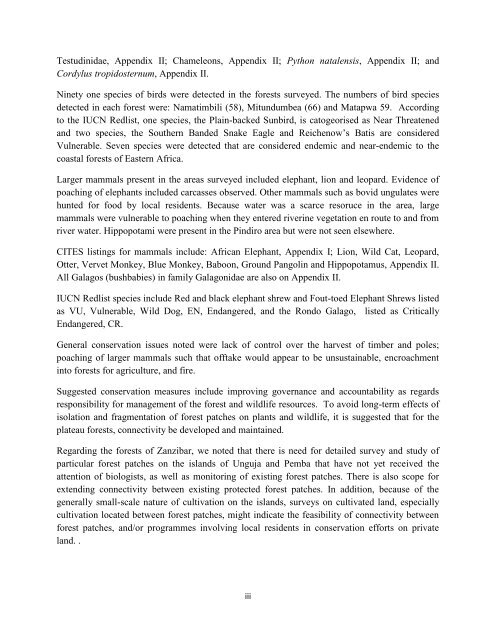Biodiversity Surveys of Poorly Known Coastal Forests of ...
Biodiversity Surveys of Poorly Known Coastal Forests of ...
Biodiversity Surveys of Poorly Known Coastal Forests of ...
Create successful ePaper yourself
Turn your PDF publications into a flip-book with our unique Google optimized e-Paper software.
Testudinidae, Appendix II; Chameleons, Appendix II; Python natalensis, Appendix II; and<br />
Cordylus tropidosternum, Appendix II.<br />
Ninety one species <strong>of</strong> birds were detected in the forests surveyed. The numbers <strong>of</strong> bird species<br />
detected in each forest were: Namatimbili (58), Mitundumbea (66) and Matapwa 59. According<br />
to the IUCN Redlist, one species, the Plain-backed Sunbird, is catogeorised as Near Threatened<br />
and two species, the Southern Banded Snake Eagle and Reichenow’s Batis are considered<br />
Vulnerable. Seven species were detected that are considered endemic and near-endemic to the<br />
coastal forests <strong>of</strong> Eastern Africa.<br />
Larger mammals present in the areas surveyed included elephant, lion and leopard. Evidence <strong>of</strong><br />
poaching <strong>of</strong> elephants included carcasses observed. Other mammals such as bovid ungulates were<br />
hunted for food by local residents. Because water was a scarce resoruce in the area, large<br />
mammals were vulnerable to poaching when they entered riverine vegetation en route to and from<br />
river water. Hippopotami were present in the Pindiro area but were not seen elsewhere.<br />
CITES listings for mammals include: African Elephant, Appendix I; Lion, Wild Cat, Leopard,<br />
Otter, Vervet Monkey, Blue Monkey, Baboon, Ground Pangolin and Hippopotamus, Appendix II.<br />
All Galagos (bushbabies) in family Galagonidae are also on Appendix II.<br />
IUCN Redlist species include Red and black elephant shrew and Fout-toed Elephant Shrews listed<br />
as VU, Vulnerable, Wild Dog, EN, Endangered, and the Rondo Galago, listed as Critically<br />
Endangered, CR.<br />
General conservation issues noted were lack <strong>of</strong> control over the harvest <strong>of</strong> timber and poles;<br />
poaching <strong>of</strong> larger mammals such that <strong>of</strong>ftake would appear to be unsustainable, encroachment<br />
into forests for agriculture, and fire.<br />
Suggested conservation measures include improving governance and accountability as regards<br />
responsibility for management <strong>of</strong> the forest and wildlife resources. To avoid long-term effects <strong>of</strong><br />
isolation and fragmentation <strong>of</strong> forest patches on plants and wildlife, it is suggested that for the<br />
plateau forests, connectivity be developed and maintained.<br />
Regarding the forests <strong>of</strong> Zanzibar, we noted that there is need for detailed survey and study <strong>of</strong><br />
particular forest patches on the islands <strong>of</strong> Unguja and Pemba that have not yet received the<br />
attention <strong>of</strong> biologists, as well as monitoring <strong>of</strong> existing forest patches. There is also scope for<br />
extending connectivity between existing protected forest patches. In addition, because <strong>of</strong> the<br />
generally small-scale nature <strong>of</strong> cultivation on the islands, surveys on cultivated land, especially<br />
cultivation located between forest patches, might indicate the feasibility <strong>of</strong> connectivity between<br />
forest patches, and/or programmes involving local residents in conservation efforts on private<br />
land. .<br />
iii

















